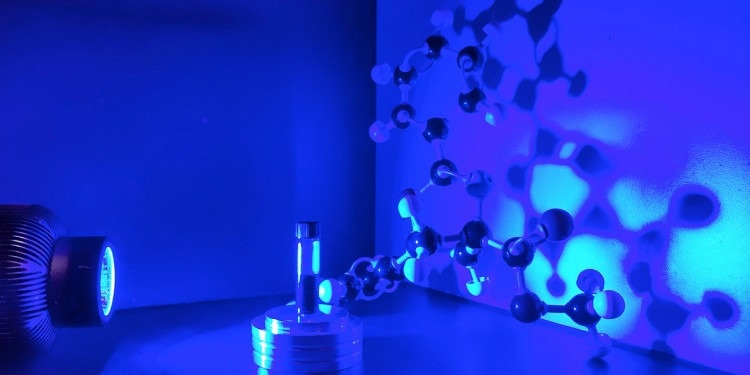A research team at the University of Münster, led by chemist Professor Dr. Frank Glorius, has developed a novel process for creating so-called heteroatom-substituted 3D molecules. The findings have been published in the journal Nature Catalysis. Novel structures are produced by carefully introducing a triatomic unit into the strained (high-energy) ring of a reaction.

Using light energy and a light-sensitive catalyst, the team produced a new type of stable three-dimensional ring from bicyclobutane. Image Credit: AG Glorius – Dr. Chetan Chintawar (symbolic photo)
As the name implies, ring-shaped "cage molecules" have a cage-like 3D structure, giving them greater stability than similar flat molecules. This enhanced stability makes them a potential interest for drug developers, offering an alternative to traditional molecular rings from the aromatic compound group.
Aromatic rings are flat rings in organic compounds and are one of the most often used components in agrochemicals and medications. In physiological settings, these structures may become unstable, reducing the efficacy of pharmacological substances.
Scientists have been investigating complex 3D solutions to fix this issue, including cage-like rings, which are more stable due to their stiffness. It has been considerably more challenging to create 3D equivalents of flat rings that contain one or more extra significant atoms, such as oxygen, sulfur, or nitrogen, although 3D substitutes for simple flat rings, like benzene (a ring with six carbon atoms), are currently accessible.
In drugs, these so-called "heteroaromatic" rings are especially prevalent.
The University of Münster team made a breakthrough by employing light energy to initiate a chemical reaction with the extremely reactive molecule bicyclobutane.
By using a light-sensitive catalyst, we were able to precisely insert nitrogen, oxygen, and carbon atoms into this very reactive small bicyclic molecule which allowed us to synthesize a new type of 3D ring.
Dr. Frank Glorius, Professor, University of Münster
Early research focused on inserting carbon atoms into bicyclobutane. Contrastingly, new cage-like 3D ring analogs are created by introducing heteroatoms like oxygen and/or nitrogen.
These new rings could potentially serve as a substitute for flat heteroaromatic rings in drug molecules, opening up new possibilities for drug development.
Dr. Chetan Chintawar,Professor, University of Münster
The synthesized rings are valuable building blocks for creating different cyclic compounds due to their stability, adaptability, and ease of modification.
The researchers conducted computational and experimental investigations to comprehend the reaction's mechanism. They proposed that the light-induced electron transfer event from the activated catalyst to the reactants that supply the final products starts the reaction.
The study was funded by the German Research Foundation, the Alexander von Humboldt Foundation, and the German Academic Exchange Service.
Journal Reference:
Chintawar, C. C., et al. (2024) Photoredox-catalysed amidyl radical insertion to bicyclo[1.1.0]butanes. Nature Catalysis. doi.org/10.1038/s41929-024-01239-9.